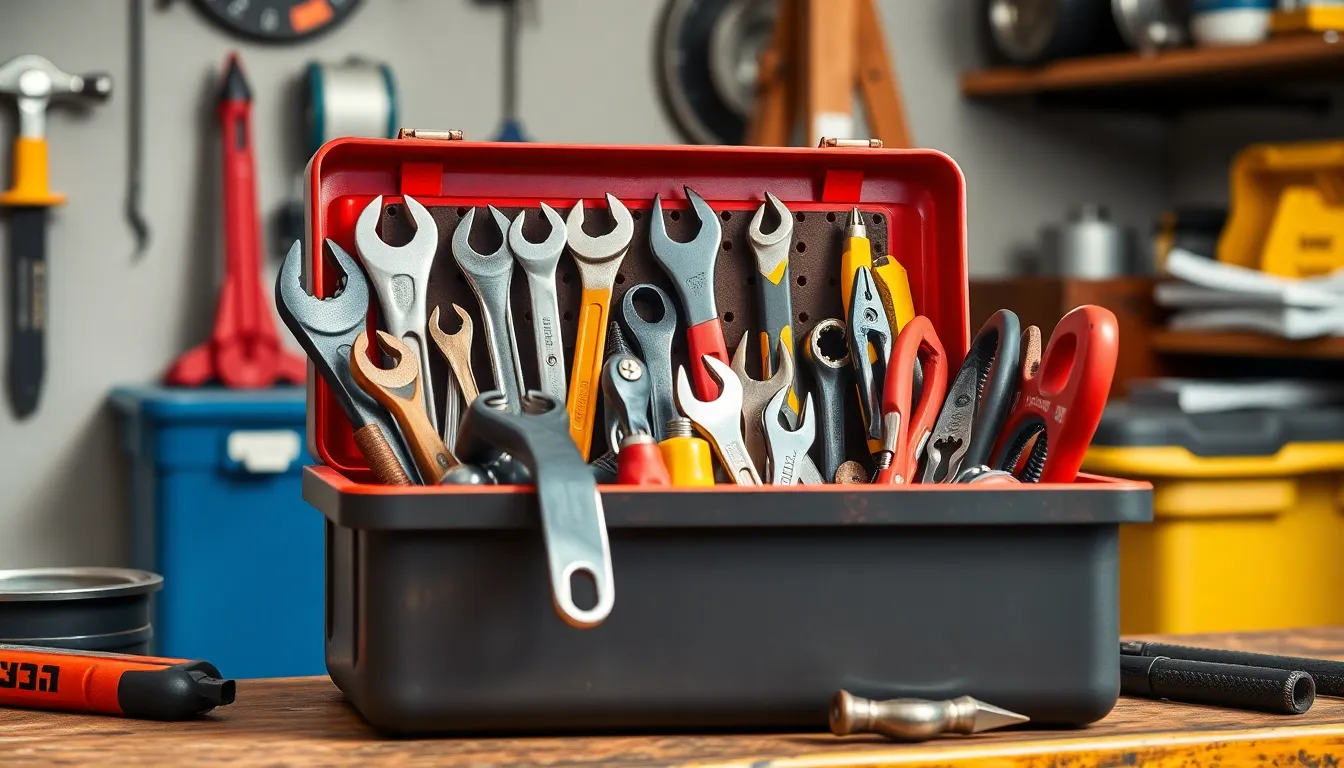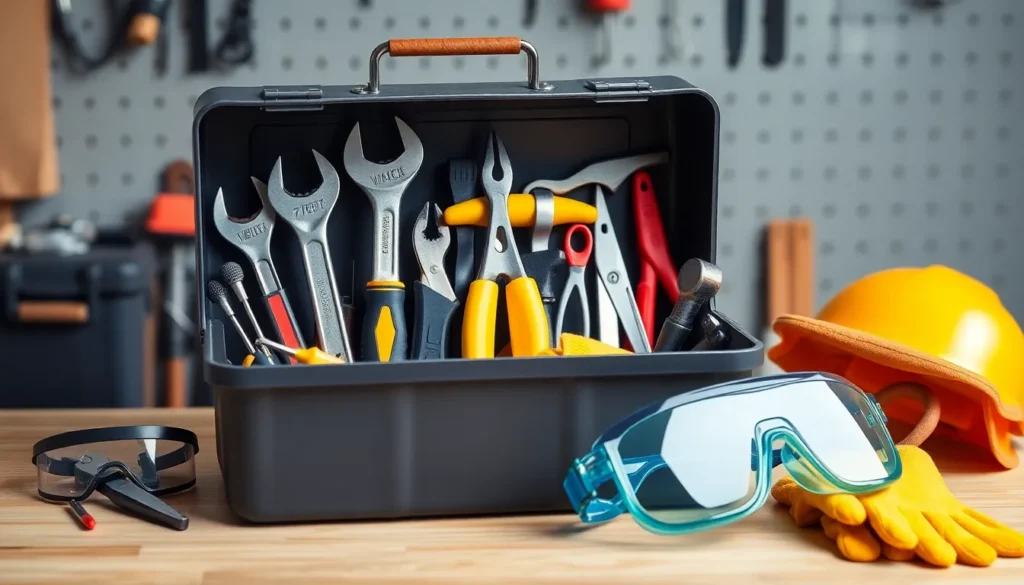Every DIY enthusiast knows that a well-stocked toolbox is the secret weapon for conquering home projects. Whether it’s fixing a leaky faucet or assembling that IKEA masterpiece, having the right tools at hand can turn a daunting task into a walk in the park—or at least a jog through the park. Picture this: you’re armed with a trusty hammer and a level, ready to tackle anything. But wait! What if you’re missing that one essential tool? Cue the dramatic music.
Table of Contents
ToggleOverview of Toolbox Essentials
A well-stocked toolbox contains essential tools crucial for home improvement tasks. These tools enhance efficiency and simplify a range of projects, from basic repairs to complex assemblies.
Common items found in toolbox essentials include:
- Adjustable Wrenches: These versatile tools fit various nut and bolt sizes, aiding in plumbing and mechanical tasks.
- Screwdrivers: Both flat-head and Phillips-head screwdrivers are vital for assembling furniture and securing fixtures.
- Pliers: They assist in gripping, twisting, and cutting wires or small items, making them useful in electrical projects.
- Hammer: A reliable hammer is necessary for driving nails and providing a solid force for construction tasks.
- Tape Measure: Accurate measurements are crucial, and a tape measure ensures precision in projects involving cuts and fittings.
- Utility Knife: This tool serves various purposes, from opening boxes to making precise cuts on different materials.
Safety equipment also belongs in every toolbox. Items such as safety goggles, gloves, and ear protection help prevent injuries during work.
Toolboxes facilitate organization. By keeping tools stored properly, it prevents misplacement and ensures easy access.
Having a compact and durable toolbox protects tools from damage and allows for mobility. Portable options benefit those who work on multiple sites.
Prioritizing these essentials provides a solid foundation for any DIY enthusiast, making projects manageable and enjoyable. Investors in their toolbox often find themselves prepared to tackle challenges with confidence.
Essential Hand Tools

Essential hand tools form the backbone of any toolbox, enabling efficient completion of various projects. Keeping these tools organized and easily accessible makes tasks much simpler.
Wrenches
Wrenches come in various sizes, with adjustable wrenches offering versatility for different fasteners. Socket wrenches provide speed and ease when tightening or loosening nuts and bolts. A set of combination wrenches, which include both open and closed ends, fulfills most standard needs. These tools significantly improve grip and torque, ensuring better results on mechanical tasks. Prioritize investing in high-quality wrenches to avoid stripping fasteners and ensure longevity.
Screwdrivers
Screwdrivers play a crucial role in countless tasks, from assembling furniture to opening electronic devices. A complete set includes flathead, Phillips, and precision screwdrivers, catering to diverse screw types. Magnetic tips provide convenience by holding screws in place during installation. Quality screwdriver sets often feature ergonomic handles that increase comfort and reduce hand fatigue. Ensure to select models that meet the specific requirements of DIY projects for optimal efficiency.
Pliers
Pliers serve multiple functions and are indispensable for gripping, twisting, and cutting tasks. Needle-nose pliers offer precision for reaching into tight spaces while cutting pliers simplify wire cutting and stripping. Lineman’s pliers excel in gripping and twisting heavy-duty materials. Choose pliers with textured grips for better control during use. Selecting the right type of pliers enhances productivity and contributes to successful project outcomes.
Power Tools to Consider
Selecting the right power tools enhances efficiency in DIY projects. These tools streamline tasks and improve overall results.
Drills
Drills are essential for creating holes in various materials, including wood, metal, and plastic. Corded drills offer consistent power, making them suitable for heavy-duty tasks. Cordless drills provide portability and convenience, allowing users to work in tight spaces without limitations. A drill with adjustable speed settings offers versatility, catering to different materials and projects. Investing in quality drill bits further enhances performance and extends tool life. Models featuring built-in lights increase visibility in dim areas. Overall, having both types of drills ensures readiness for any project.
Saws
Saws play a vital role in cutting materials to the desired size and shape. Circular saws excel at straight cuts, delivering speed and precision in wood and other materials. Jigsaws are ideal for intricate cuts and curves, providing flexibility in design. A miter saw handles angled cuts effortlessly, making it perfect for framing and molding tasks. Safety features, such as blade guards and electric brakes, enhance user protection. Choosing saws based on specific projects helps optimize effectiveness and results. Each type of saw serves a unique purpose, ensuring individuals are well-equipped for various cutting tasks.
Organizing Your Toolbox
A well-organized toolbox streamlines projects and keeps tools accessible. Knowing how to store and maintain tools enhances their longevity and performance.
Tool Storage Solutions
Choosing the right storage solutions is vital for organization. Tool chests with drawers offer neat organization for various hand tools and power tools. Portable toolboxes allow easy transport and access, making them ideal for on-the-go projects. Magnetic tool holders keep frequently used tools within reach, reducing search time. Pegboards enable vertical storage, maximizing wall space in workshops. Utilizing clear bins lets you see contents at a glance, simplifying tool identification.
Maintenance Tips
Regular maintenance keeps tools in peak condition. Cleaning tools after use prevents rust and damage. Wipe down metal surfaces with a light oil to protect them from moisture. Sharpening blades and bits periodically improves effectiveness. Inspect cords on power tools for fraying or damage to ensure safety during use. Finally, storing tools in a dry environment prevents moisture accumulation and prolongs tool life.
Selecting Quality Tools
Choosing quality tools significantly impacts the success of any DIY project. Quality materials ensure durability and improve performance, making tasks easier and more efficient. When selecting tools, favor well-known brands with strong reputations for quality, as they consistently deliver better long-term results.
Examine the materials used in tool construction. High-grade steel usually offers strength and resistance to wear, while comfortable grips provide better handling. Consider the tool design; ergonomic tools enhance functionality and reduce fatigue during extended use.
Determine the specific requirements for each project. For tasks requiring precision, invest in specialized tools like torque wrenches or precision screwdrivers. Heavy-duty projects benefit from robust tools that can withstand wear, such as high-strength pliers or sturdy saws.
Check product reviews and user feedback. Genuine user experiences offer insights into the performance and durability of tools. Visiting hardware stores can provide further advantages; many retailers allow customers to test tools before purchasing.
Remember to look for warranties or guarantees. Reliable manufacturers often provide solid warranties, demonstrating confidence in their product’s performance and longevity. Such assurances can also protect investments in essential tools.
Prioritize safety features, especially for power tools. Features like electric brakes, stability controls, and protective guards contribute to safer operation. Select tools that include these features to minimize risks during use.
Maintaining tools ensures they perform optimally over time. Regular inspections for wear, cleaning after use, and appropriate storage can prolong tool life. Investing time in maintenance translates to smoother project executions.
Having the right tools at hand is crucial for any DIY enthusiast. A well-stocked toolbox not only simplifies tasks but also boosts confidence when tackling home improvement projects. Prioritizing quality and organization ensures that tools remain effective and accessible.
Investing in essential hand and power tools can significantly enhance efficiency. Additionally, maintaining tools and incorporating safety equipment is vital for a successful and safe DIY experience. With these essentials in place, anyone can approach their next project with the assurance that they’re well-prepared to achieve great results.





